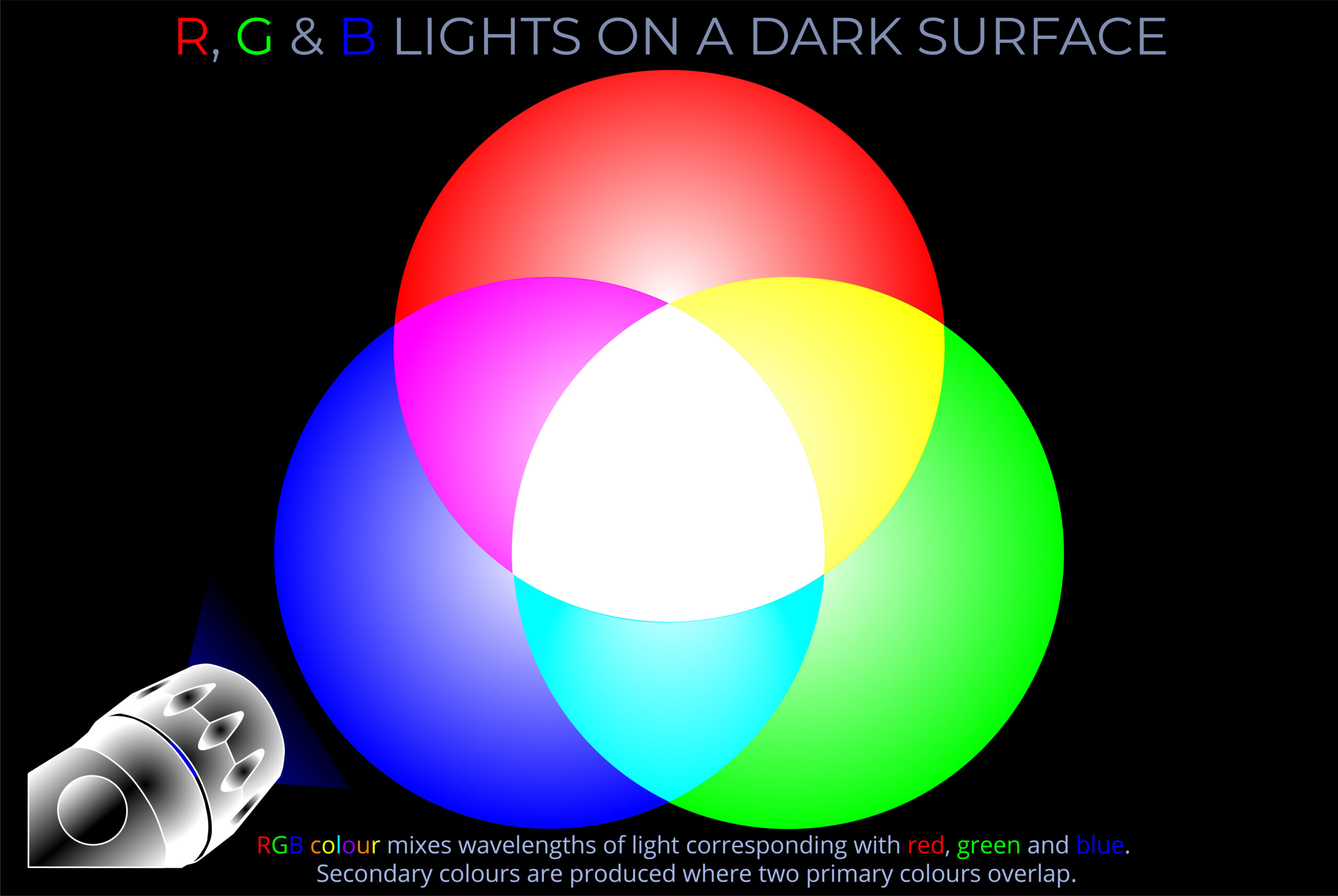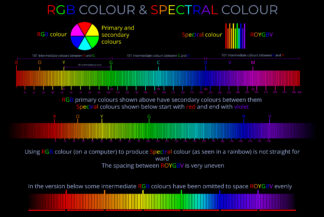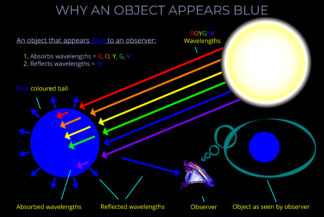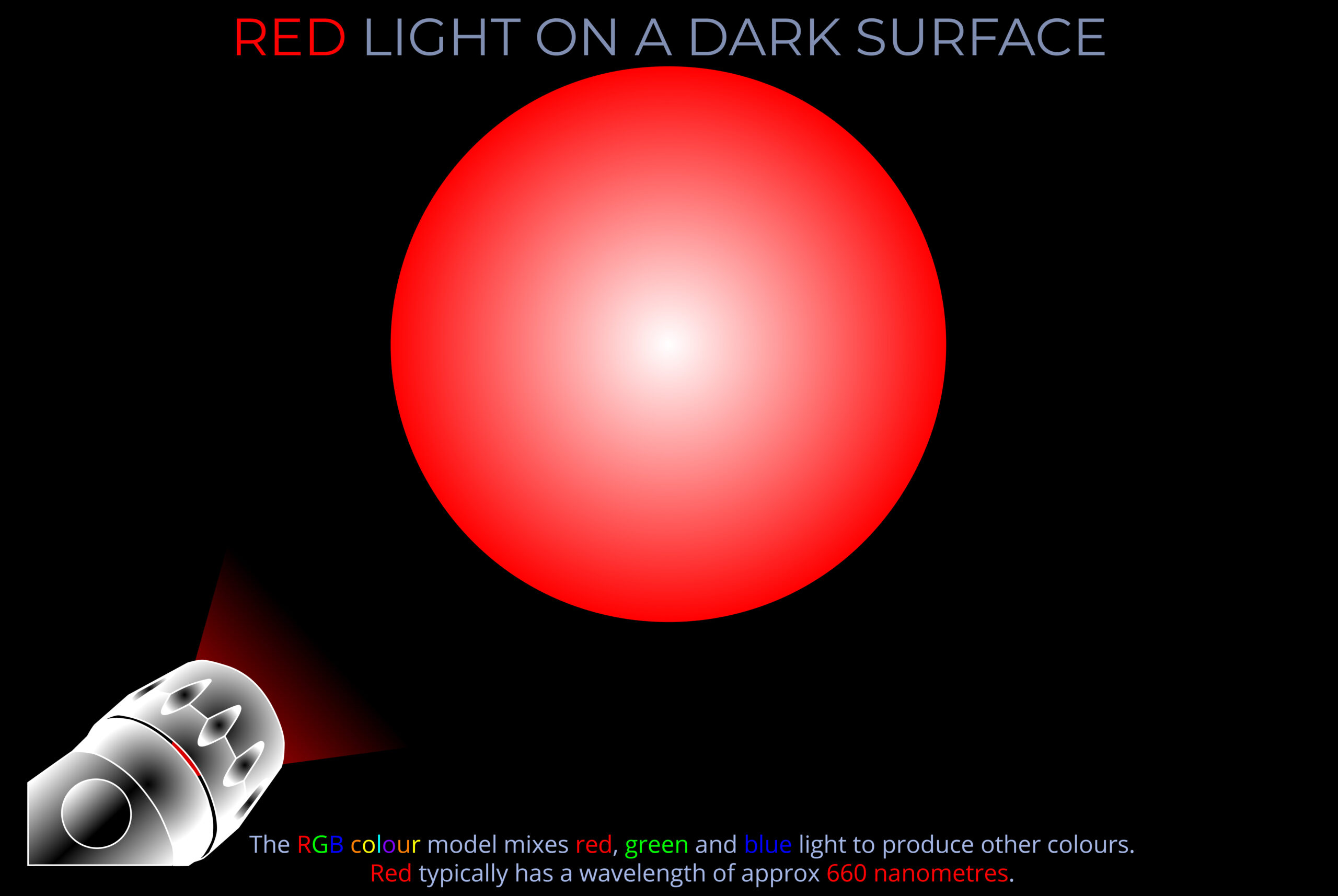R G & B Lights on a Dark Surface
£0.00
This diagram shows the effect of projecting red, green and blue light onto a neutral coloured surface.
- Imagine that the three circles of colour (red, green and blue) are produced by three torches shining beams of light so they overlap one another.
- Overlapping pairs of primary colours produce secondary colours.
- Overlapping pairs of secondary colours produce primary colours.
- The area where all three primary colours overlap is white.
Understanding the diagram:
- The diagrams illustrate how the RGB colour model works in practice.
- Each torch emits light at the same intensity.
- Each torch points towards a different area of the surface.
- The light in each case is of a single wavelength so produces a spectral colour.
- The selected wavelengths are: red = 660 nanometres (nm), green = 525 nm, blue = 460 nm.
Description
R, G & B Lights on a Dark Surface
TRY SOME QUICK QUESTIONS AND ANSWERS TO GET STARTED
About the diagram
About the diagram
- This diagram shows the effect of projecting red, green and blue light onto a neutral coloured surface.
- Imagine that the three circles of colour (red, green and blue) are produced by torches shining beams of light so they overlap one another.
- Overlapping pairs of primary colours produce secondary colours.
- Overlapping pairs of secondary colours produce primary colours. (No surprise there!)
- The area where all three primary colours overlap is white.
Understanding the diagram
- The diagrams illustrate how the RGB colour model works in practice.
- Each torch emits light at the same intensity.
- Each torch points towards a different area of the surface.
- The light in each case is of a single wavelength so produces a spectral colour.
- The selected wavelengths are: red = 660 nanometres (nm), green = 525 nm, blue = 460 nm.
About the RGB colour model
- RGB colour is an additive colour model that combines wavelengths of light corresponding with the red, green and blue primary colours to produce other colours.
- RGB colour is called a model because it is a method that can be followed to produce a full gamut of colours.
- Red, green and blue are called additive primary colours in an RGB colour model because they can be added together to produce all other colours.
- Each of the three beams is called a component of the resulting colour.
- Different colours are produced by varying the intensity of the component colours between fully off and fully on.
- When any two fully saturated additive primaries are combined they produce a secondary colour: yellow, cyan and magenta.
- When fully saturated red, green and blue primary colours are combined they produce white.
- Some RGB colour models can produce over 16 million colours by varying the proportion and intensity of each of the three component primary colours.
- The additive RGB colour model cannot be used for mixing different colours of pigments, paints, inks, dyes or powder. To understand these colourants find out about subtractive colour.
Some key terms
RGB colour is an additive colour model in which red, green and blue light is combined to reproduce a wide range of other colours.
- The primary colours in the RGB colour model are red, green and blue.
- In the RGB model, different combinations and intensities of red, green, and blue light are mixed to create various colours. When these three colours are combined at full intensity, they produce white light.
- Additive colour models are concerned with mixing light, not dyes, inks or pigments (these rely on subtractive colour models such as the RYB colour model and the CMY colour model).
- The RGB colour model works in practice by asking three questions of any colour: how red is it (R), how green is it (G), and how blue is it (B).
- The RGB model is popular because it can easily produce a comprehensive palette of 1530 vivid hues simply by adjusting the combination and amount of each of the three primaries it contains.
A light source is a natural or man-made object that emits one or more wavelengths of light.
- The Sun is the most important light source in our lives and emits every wavelength of light in the visible spectrum.
- Celestial sources of light include other stars, comets and meteors.
- Other natural sources of light include lightning, volcanoes and forest fires.
- There are also bio-luminescent light sources including some species of fish and insects as well as types of bacteria and algae.
- Man-made light sources of the most simple type include natural tars and resins, wax candles, lamps that burn oil, fats or paraffin and gas lamps.
- Modern man-made light sources include tungsten light sources. These are a type of incandescent source which means they radiate light when electricity is used to heat a filament inside a glass bulb.
- Halogen bulbs are more efficient and long-lasting versions of incandescent tungsten lamps and produce a very uniform bright light throughout the bulb’s lifetime.
- Fluorescent lights are non-incandescent sources of light. They generally work by passing electricity through a glass tube of gas such as mercury, neon, argon or xenon instead of a filament. These lamps are very efficient at emitting visible light, produce less waste heat, and typically last much longer than incandescent lamps.
- An LED (Light Emitting Diode) is an electroluminescent light source. It produces light by passing an electrical charge across the junction of a semiconductor.
- Made-made lights can emit a single wavelength, bands of wavelengths or combinations of wavelengths.
- An LED light typically emits a single colour of light which is composed of a very narrow range of wavelengths.
White light is the term for visible light that contains all wavelengths of the visible spectrum at equal intensities.
- The sun emits white light because sunlight contains all the wavelengths of the visible spectrum in roughly equal proportions.
- Light travelling through a vacuum or a medium is termed white light if it includes all wavelengths of visible light.
- Light travelling through a vacuum or air is not visible to our eyes unless it interacts with something.
- The term white light can have two meanings:
- It can refer to a combination of all wavelengths of visible light travelling through space, regardless of observation.
- What a person sees when all colours of the visible spectrum hit a white or neutral-coloured surface.
A secondary colour is created by mixing two primary colours in equal parts. The primary colours may belong to either an additive colour model, which combines wavelengths of light, or a subtractive colour model, which mixes pigments or dyes.
- In additive colour models such as the RGB colour model, which deals with the effects of mixing coloured light, a secondary colour results from overlapping the primary colours: red, green, and blue. The secondary colours produced by combining pairs of primary colours in the RGB model are cyan, magenta, and yellow.
- In subtractive colour models such as the CMY colour model, which is concerned with mixing dyes and inks, a secondary colour results from overlapping the primary colours: cyan, magenta, and yellow. The secondary colours produced by combining pairs of primary colours in the CMY model are red, green, and blue.
Primary colours are a set of colours from which others can be produced by mixing (pigments, dyes etc.) or overlapping (coloured lights).
- The human eye, and so human perception, is tuned to the visible spectrum and so to spectral colours between red and violet. It is the sensitivity of the eye to the electromagnetic spectrum that results in the perception of colour.
- A set of primary colours is a set of pigmented media or coloured lights that can be combined in varying amounts to produce a wide range of colours.
- This process of combining colours to produce other colours is used in applications intended to cause a human observer to experience a particular range of colours when represented by electronic displays and colour printing.
- Additive and subtractive models have been developed that predict how wavelengths of visible light, pigments and media interact.
- RGB colour is a technology used to reproduce colour in ways that match human perception.
- The primary colours used in a colour space such as CIELAB, NCS, Adobe RGB (1998) and sRGB are the result of an extensive investigation of the relationship between visible light and human colour vision.
- A colour wheel is a circular diagram divided into segments, featuring primary colours, and used to visualize the result of colour mixing.
- Colour wheels can enhance understanding of colour relationships and assist with the accurate selection and reproduction of colours.
- A colour wheel starts with segments representing primary colours. Additional segments are added between them to explore the outcome of mixing adjacent primary colours.
- By adding more segments between existing ones, further mixing of adjacent colours can be explored.
- A colour wheel exploring the additive RGB colour model starts with red, green, and blue primary colours.
- A colour wheel exploring the subtractive CMY colour model starts with cyan, magenta, and yellow primary colours.



